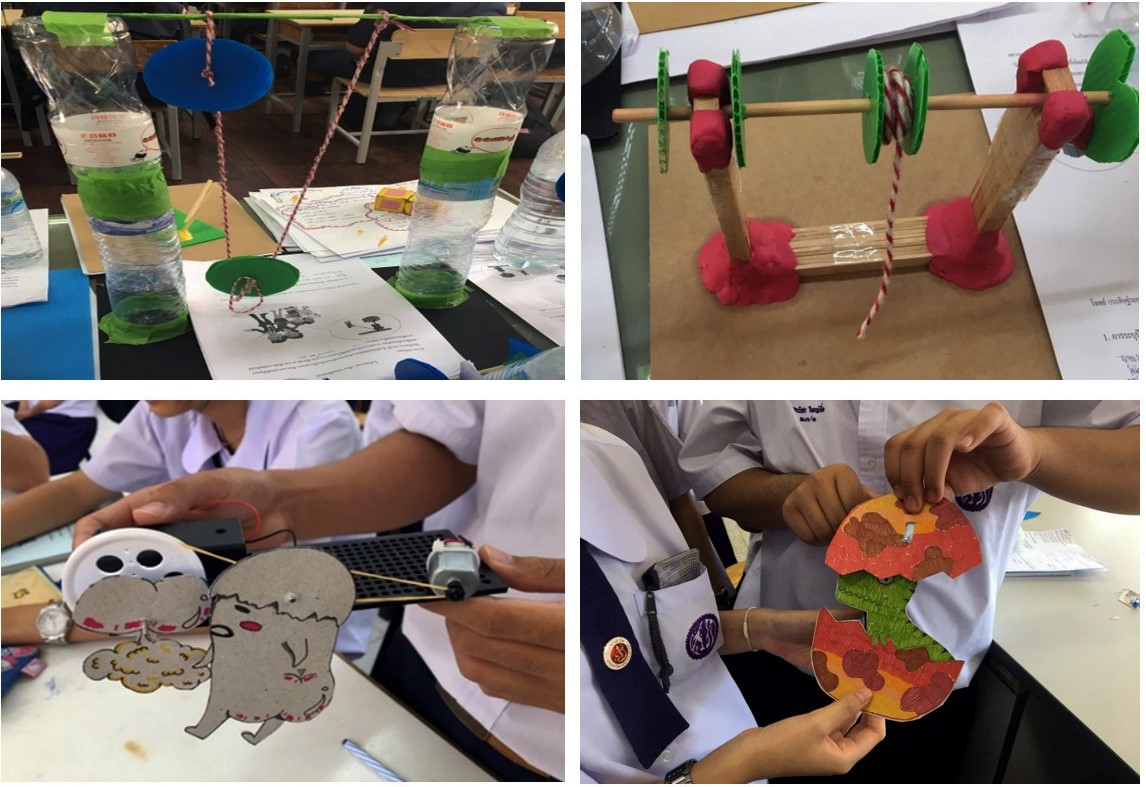การพัฒนาความคิดสร้างสรรค์และความรู้ความเข้าใจเกี่ยวกับเครื่องกลอย่างง่ายผ่านการจัดการเรียนรู้แบบสืบเสาะหาความรู้ตามแนวทางสะเต็มศึกษาของนักเรียนระดับชั้นมัธยมศึกษาปีที่ 3
Main Article Content
Abstract
Sirporn Kruatong and Supattra Faykhan
รับบทความ: 18 สิงหาคม 2563; แก้ไขบทความ: 27 พฤศจิกายน 2563; ยอมรับตีพิมพ์: 12 ธันวาคม 2563; ตีพิมพ์ออนไลน์: 5 พฤษภาคม 2564
บทคัดย่อ
การวิจัยนี้มีวัตถุประสงค์เพื่อส่งเสริมความคิดสร้างสรรค์และความรู้ความเข้าใจเกี่ยวกับเครื่องกลอย่างง่ายด้วยการจัดการเรียนรู้แบบสืบเสาะหาความรู้ตามแนวทางสะเต็มศึกษา กลุ่มที่ศึกษาเป็นนักเรียนระดับชั้นมัธยมศึกษาปีที่ 3 จำนวน 114 คน การจัดการเรียนรู้แบบสืบเสาะหาความรู้ตามแนวทางสะเต็มศึกษาเป็นการผนวกกิจกรรมสะเต็มศึกษาร่วมกับเทคนิคการตรวจสอบรายการความคิดสร้างสรรค์ในขั้นการขยายความรู้ของกระบวนการสอนแบบสืบเสาะหาความรู้ 5Es เครื่องมือที่ใช้ในการวิจัยนี้ ได้แก่ 1) แบบวัดความคิดสร้างสรรค์ 2) แบบวัดความรู้ความเข้าใจเกี่ยวกับเครื่องกลอย่างง่าย และ 3) แบบสัมภาษณ์กึ่งโครงสร้าง การวิเคราะห์ข้อมูลใช้ค่าเฉลี่ยเลขคณิต ส่วนเบี่ยงเบนมาตรฐาน และการทดสอบที ผลการศึกษาพบว่า การจัดการเรียนรู้แบบสืบเสาะหาความรู้ตามแนวทางสะเต็มศึกษาสามารถพัฒนาให้นักเรียนได้รับประสบการณ์การพัฒนาความคิดสร้างสรรค์ผ่านการเรียนเนื้อหาเรื่องเครื่องกลอย่างง่ายที่ต้องเชื่อมโยงแนวคิดวิทยาศาสตร์ไปสู่การผลิตชิ้นงานในชีวิตประจำวัน เช่น เครนยกของ รอก รถของเล่น ตุ๊กตาดุ๊กดิ๊ก ผลการประเมินคะแนนเฉลี่ยความคิดสร้างสรรค์และความรู้ความเข้าใจเกี่ยวกับเครื่องกลอย่างง่ายหลังเรียนสูงกว่าก่อนเรียน (p < 0.01) และผลคะแนนความคิดสร้างสรรค์กับความเข้าใจต่อการเรียนเรื่องเครื่องกลอย่างง่ายของนักเรียนมีความสัมพันธ์กันทางบวกระดับค่อนข้างสูง โดยมีค่าสัมประสิทธิ์สหสัมพันธ์ของเพียร์สันเท่ากับ 0.742
คำสำคัญ: ความคิดสร้างสรรค์ เครื่องกลอย่างง่าย การจัดการเรียนรู้แบบสืบเสาะหาความรู้ตามแนวทางสะเต็มศึกษา
Abstract
This research aimed to enhance the creativity and science content knowledge of ninth grade students through STEM inquiry–based learning in topic of simple machine. The research participants were 114 ninth grade students. The STEM inquiry–based lesson plans including STEM activities and creativity checklist technique in the elaboration stage of 5Es inquiry were used in this study. Research tools were: 1) a creativity test, 2) an understanding test in simple machine concepts, and 3) a semi–structured interview form. The arithmetic mean, standard deviation and t–test were used to analyze the data. The finding showed that the teaching and learning through STEM Inquiry–based learning was able to develop students to gain creativity in work experience connected science concepts to real–life products, e.g., cranes, reel, toy cars and nonstop dolls. The average posttest scores of creativity and understanding of simple machine were higher than those of pretest (p < 0.01). The students’ scores of creativity and understanding of simple mechanical learning were positively correlated at moderate level with Pearson’s correlation coefficient of 0.742.
Keywords: Creative thinking, Simple machine, STEM inquiry–based learning
Downloads
Article Details

This work is licensed under a Creative Commons Attribution-NonCommercial 4.0 International License.
References
Bybee, R. (1993). An Instructional Model for Science Education: In Developing Biological Literacy. Colorado Spring: Biological Sciences Curriculum Study.
Chareonwongsak, K. (2013). Creative Thinking. Bangkok: Success Media. (in Thai)
Chomngam, C., Na Phatthalung, R., Wongtha, C., Phatokkumlaw, S., Nararakwong, N., and Boonpho, V. (2018). The development of creativity and teamwork through the STEM education learning process of the students in the Engineering Science classroom, King Mongkut's University of Technology Thonburi (ESC-KMUTT), King Mongkut’s University of Technology Thonburi. CMU Journal Education 2(1): 33–55. (in Thai)
Erickson, F. (1986). Qualitative methods in research on teaching. In Wittrock, M. C. (Ed.). The Handbook of Research on Teaching. New York: MacMillan.
Guilford, J. P. (1950). Creativity. American Psychologist 5: 444–454.
Hajeehadae, A. (2017). Effect of STEM Education Approach on Biology Achievement, Scientific Creativity and Instructional Satisfaction of Grade 11 Students. Master of Education in Teaching Science and Mathematics. Songkla: Prince Songkla University. (in Thai)
Kruatong, S. (2017). Development of Science Student Teachers’ Ability in Preparing STEM Inquiry–Lessons. PhD Thesis in Science Education. Bangkok: Kasetsart University. (in Thai)
Malik A., Setiawan A., Suhandi A., and Permanasari A. (2017). Enhancing pre–service physics teachers’ creative thinking skills through HOT Lab design. AIP Conference Proceeding. doi: 10.1063/1/4995177.
Martin, J. Beel, R., Farmer, E., and Henry, J. (2010). Creativity, Innovation and Change: Technique Library. UK: Miton Keynes.
Mayasari, T., Kadarohman, A., Rusdiana D., and Kaniawati, I. (2016). Exploration of student’s creativity by integrating STEM knowledge into creative products. AIP Conference Proceedings 1708: 080005.
Neuman, W. L. (2003). Social Research Methods: Qualitative and Quantitative Approaches. 5th ed. Boston: Allyn & Bacon.
Newton, L., and Newton, D. (2010). Creative thinking and teaching for creativity in elementary school science. Gifted and Talented International 25(2): 111–124.
Nuangchalerm, P. (2018). STEM education and Kolb’s learning style. Journal of Community Development Research (Humanities and Social Sciences) 11(2): 11–17. (in Thai)
Osborn, A. (1988). Applied Imagination. 3rd ed. New York: Scribners.
Pimthong, P., and Williams, J. (2020). Preservice teachers’ understanding of STEM education. Kasetsart Journal of Social Sciences 41: 289–295.
Serirat, S. (2006). Service Marketing. Bangkok: SE–ED Education. (in Thai)
Sriratana, J. (2018). Creative Economy with Thailand 4.0. Kasem Bundit Journal 19: 208–217. (in Thai)
Tidma, P., Nakkuntod, M., and Kijkuakul, S. (2015). STEM education in topic of human systems to promote creative thinking of 8th grade students. Ratchaphruek Journal 13(3): 71–76. (in Thai)
Wongchachom, P., and Cojorn, K. (2016). A development of creative thinking and learning achievement of Matthayomsueksa 5 students based on the STEM education cooperated with project–based learning. Journal of Education, Mahasarakham University 10: 463–474. (in Thai)
